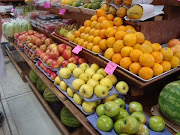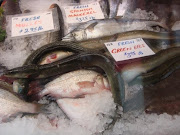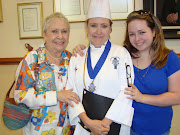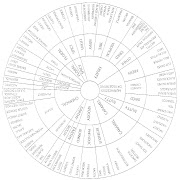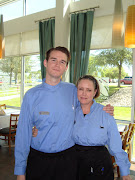For those of you following my blog, I apologize for neglecting to update prior to now. However, I have been ridiculously busy with school, work and life in general. So, without further ado, here's the lowdown on an amazing night.
Last night was my final exam in my last class at the Texas Culinary Academy - Le Cordon Bleu. We were required to prepare a three course meal from ingredients in a "mystery basket". It was the epitome of intimidating. For those of you who have seen Food Network's "Chopped" you know what "mystery basket" means. Here's the explanation for those of you who don't.
We are given ingredients that MUST be used in the preparation of a three course meal. The dinner must include an appetizer, an entree (which includes a protein, a starch, a vegetable and a sauce) and dessert. We are given full use of the kitchen pantry (which is fairly limited) and only the vegetables, fruits and garnishes put in the "basket". In this case the basket included 3 proteins: scallops, chicken and NY Strip. Vegetables and other ingredients included Romaine lettuce, spinach, red and green bell peppers, potatoes, onions, shallots, mushrooms, garlic, zucchini, lemons, limes, and capers. The pantry had most dairy products (i.e. milk, cream, mozzarella cheese etc.) and standard kitchen spices and staples such as flour and sugar. We drew lots to discover which protein we were allowed to use. Thankfully, I pulled chicken from "THE TOQUE OF DESTINY"...our chef's idea of a lottery. We had specific start and presentation times that were strictly enforced.
I chose to prepare a Cesar Salad with fresh croutons, Chicken Piccata with fresh egg pasta and a lemon caper cream sauce (delicious) served beside a Vegetable Napoleon and a Pate a Choux Swan with Lemon Cream and candied mint and rose petals. We started cooking at 6:30pm and I had to present at 9:40pm. This may SOUND like plenty of time but remember...we made EVERYTHING from scratch. My dishes included a fresh pasta and a Pate a Choux (which is a type of cream puff pastry dough). Both are time consuming and require a certain amount of time to "rest" the dough before final preparation.
I began with the pasta so as to leave ample time to "rest" the dough. I moved on to the Pate a Choux swan, salad and candied mint and rose petals. When I finished those items I checked the clock and it was 9:25pm! I hadn't even gotten my chicken out of the walk-in cooler! In the final 15 minutes I pulled a rabbit out of my hat (metophorically) and butchered my chicken, rolled out my pasta, prepared the sauce and plated just in the nick of time!
I have to say that all I remember was mostly a blur of action but a fine finish. My chef instructor, Chef Earnie Beasley, thought it was "refined and elegant". Very "la, ti, da, indeed".
The following are my recipes which I think would be a perfect meal for any elegant dinner party.
Cesar Salad- the secret is the dressing and the croutons
1/2 head Romaine lettuce, washed, dried and chilled
1 clove garlic, pasted
2 anchovy fillets, pasted
6 oz. Extra Virgin Olive Oil
1 egg yolk
1/2 lemon
2 T. grated parmesan cheese
1 t. dijon mustard
1 T. red wine vinegar
Salt as needed
Pepper as needed
water as needed
1 dash of Worcestershire (if you like it)
Paste the garlic and anchovy fillets with a chef's knife or mortar and pestle. In a large stainless steel bowl whisk egg yolk to Sabayon consistency (whisk until pale yellow in color and the consistency of cream). Add a little water to keep it to proper consistency. Add in rest of ingredients except olive oil. Add the first 2 oz. of olive oil slowly while whisking constantly to emulsify. Once the first 2 oz. are emulsified you can add the rest quicker but continuous whisking is important. Dress the Romaine (I do it with my hands). Plate with croutons and fresh parmesan cheese. Yields 2 servings.
Fresh Croutons (thank God I didn't have to bake the bread!)
1/2 French Baguette
1/2 c. Olive Oil
1 garlic clove, whole
Salt as needed
Heat olive oil in sauteuse pan (skillet) with garlic clove to infuse the oil. Cut baguette into crouton size pieces (I like them 3/4" square). Drop them in the oil (it should be pretty hot but not smokin') Saute until brown (20-45 seconds). Be sure to turn the croutons so they are evenly browned. Remove from oil with a spider or tongs. Drain on paper towels and season with salt immediately.
Fresh Egg Pasta
4 oz. Semoline Flour
4 oz. AP Flour (all purpose)
2 whole eggs
Extra Virgin Olive oil as needed
Salt as needed
AP Flour as needed
On a clean dry surface sift together Semolina, a couple of pinches of salt and AP flour. Hollow out the middle and crack 2 eggs into the flour. Mix together with hands until blended adding a little water and olive oil as needed. Knead dough until the glutens begin to form. You can tell it's happening when you push a finger in the dough and it springs back. I generally knead the dough 5-8 minutes at least! It's worth the elbow grease. Wrap in plastic wrap and rest in fridge at least 30 minutes. Roll out with a rolling pin and cut or better yet, use a a pasta machine. Drop in salted, boiling water (use copious amounts of salt in the water) and cook until al dente (about 3 minutes). Toss with butter and parsley then toss again with sauce of choice and serve immediately. Yields approximately 2 entree size portions. This can be used to make ravioli, fettuccini, spaghetti...pretty standard stuff. Very tender and delicious.
Chicken Piccata w/ Lemon Caper Cream Sauce (YUM)
2 chicken breasts, pounded and cut into 4 pieces
panko bread crumbs
1 egg, slightly beaten
1 c. heavy cream, heated
1/4 c. Extra Virgin Olive Oil
1/2 c. White Wine (I prefer to use wine I like to drink)
3 T. capers
2 garlic cloves, minced
1 shallot, minced
juice of 1 lemon
zest of 1 lemon
salt as needed
pepper as needed
AP flour as needed
1 T. butter
Heat E.V.O.O. in sauteuse pan. Pound chicken breast to 1/4" (scallopini thickness). Dredge in seasoned (with salt and pepper) AP flour, then egg, then Panko breadcrumbs. Saute chicken in E.V.O.O. until golden brown and delicious (GBD). Remove and drain on paper towels. Throw in garlic and shallot and sweat in same pan. Add lemon juice and lemon zest. Deglaze with wine and reduce to demi-sec (by 1/2 at least). Add warm cream (must be warm or your sauce will break). Reduce over medium heat until sauce coats the back of a spoon. Season to taste and add capers. Monte au buerre (turn off heat and add butter at last minute constantly agitating so as not to break your sauce). Toss with favorite pasta or you CAN put chicken back in sauce if you like...it's a prettier presentation if you just sauce the pasta and place the chicken on top of pasta. Garnish with crispy capers (just saute capers in a little hot E.V.O.O. until crispy) and parsley. DELISH! Yields approximately 4 entrees.
Vegetable Napoleon
1 red bell pepper, filleted
1 green bell pepper, filleted
1 Portobello mushroom, gills and stem removed
1 zucchini, sliced 1/4" thick stem to stern
basil, chiffonade
Extra Virgin Olive Oil as needed
Mozzarella Cheese, 2 1/4" thick slices
2 cloves garlic, minced
1 shallot minced
Salt as needed
Pepper as needed
Marinate peppers and zucchini in garlic, shallot and E.V.O.O. at least 30 minutes (be sure to season). Marinate mushroom in garlic, shallot and E.V.O.O. but NO SALT (the salt will make the shroom tough). Grill veggies on medium heat until you get nice grill marks on both sides. Cut into pieces that are the same size that will stack neatly. It should look kind of like lasagna. Stack in following order: 1 piece (3x3" is best) red bell pepper, zucchini, green bell pepper, mushroom, mozz. cheese, some basil and a drizzle of E.V.O.O. Repeat. Bake at 350 degrees until GBD. Cut in 1/2 and plate so you can see the pretty layers. Yields 1 napoleon.
Pate a Choux Swan W/ candied mint and rose petals
10 oz. water
4 oz. butter
1 t. sugar
1 t. salt
6 oz. bread flour
6-8 oz. whole eggs
Heat butter, water, sugar and salt until hard simmer. Add flour all at once. Stirring constantly over medium-high heat cook until a "carpet" forms on the bottom of the pan. The "carpet" looks like a film of flour on the bottom of the pan. You can see it when you scrape the bottom of the pan with your wooden spoon or spatula. You don't want any color on the dough at this point. Remove and place in stand mixer. Mix with paddle attachment until steam dissipates. Add eggs one at a time until dough drips from paddle in a "v". You don't want it too wet. Put in piping bag with a large star tip and pipe thick on one end and taper off to the "tail" on a parchment paper lined sheet pan. It should kinda look like a swan body. Carefully eggwash swan with a pastry brush. Bake at 375 degrees until GBD. The swan body should feel and sound hollow. Pipe on separate sheet pan (I use a Silpat) the number "2". This will form the swan head and neck. Using a paring knife, slightly form a beak on the head. Bake at 300 degrees until GBD. Using a serrated knife, cut top off of swan about a third of the way down (careful! swan is delicate) then cut the portion you remove from the top in half. This forms the wings. This recipe yields about 6-9 swans depending on size.
Lemon Cream Filling
1 1/2 c. Heavy Whipping Cream
Confectioner's Sugar to taste
Pinch of Salt
zest of 1 lemon
juice of lemon to taste
In a stand mixer (or by hand if your more ambitous than I) whip cream until foamy. Adding a little sugar at a time whip on high until stiff peaks form. Add lemon zest and juice to taste. Pipe into swan body. Stick wings and neck into cream... VOILA...a yummy swan dessert! Don't forget to garnish with a little powdered sugar and your candied mint and rose petals!
Candied Mint and Candied Rose Petals
Fresh mint
Freshly picked roses (red is prettiest - you can use any edible flower but I find roses to be the tastiest and most lovely)
1 egg white, slightly beaten
granulated sugar
Using your fingers, dab a little egg white on mint and rose petals. Sprinkle with sugar and stick in a warm place. In about 20 minutes you'll have candied mint and rose petals! A beautiful garnish!
This is a fairly time consuming meal but well worth the effort. You will impress your guests and hopefully get a great grade!!!!!!!!!!
Thanks for following my blog. I will try to be more diligent in posting future updates.
If you're checking this...muah, TBO....

